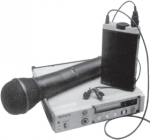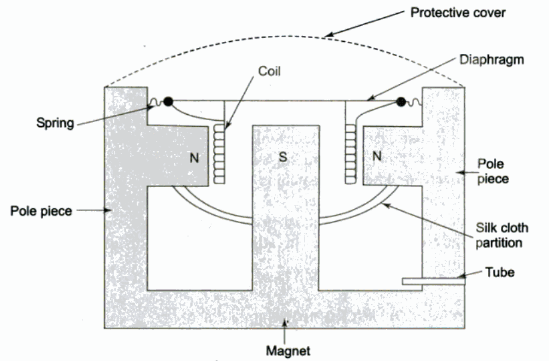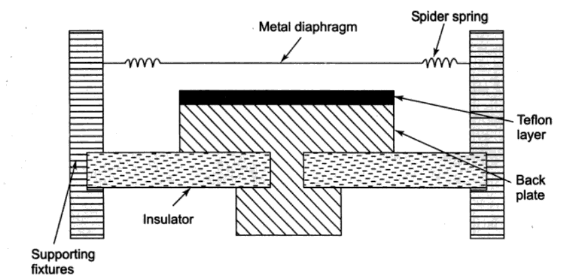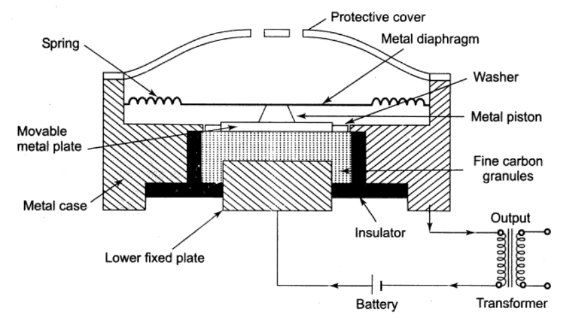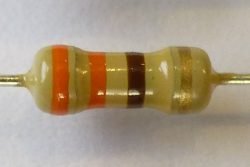MICROPHONE & its types
Microphone in short sometimes called mic or mike.
A microphone is a transducer that converts sound waves into equivalent electrical signals of the same frequency and phase. The amplitudes of the output electrical signal are the same as the sound waves. The electrical signals in the audible range are called audio signals. A microphone is the first link in sound recording and transmission systems. Audio signals can be used to cross the barrier of time (by recording) and the barrier of distance (by radio transmission).
Table of Contents
Characteristics of Microphones
A good microphone has some characteristics on these basics many microphones are good or bad. These characteristics should be high for the good one. These characteristics are-
- Sensitivity
- Signal to noise ratio
- Frequency Response
- Non-Linear Distortion
- Output Impedance
- Directivity
Types of Microphones
MOVING COIL (DYNAMIC) MICROPHONES
The moving-coil microphone (also called dynamic microphone) is the most common type of microphone. This is used on the principle of electromagnetic induction. When sound pressure variations move a coil placed in a magnetic field, there is a change of magnetic flux passing through the coil. An emf is, therefore, induced in the coil and this emf forms the output of the microphone. Due to similarity in construction, a moving coil loudspeaker can also work as a moving-coil microphone. The same unit is often used both as a microphone and loudspeaker in office intercom systems.
Construction
The moving coil microphone has a permanent magnet, which has a central pole (South Pole) and another pole (North Pole). This type of magnet gives a uniform magnetic field between the pole pieces.
The diaphragm is a thin circular sheet of non-magnetic material and is lightweight. It is fixed to the body of the magnet with the help of springs. The springs provide compliance to the motion of a diaphragm and coil assembly provides the inductive effect.
The coil is wound on a cardboard cylinder which is attached to the diaphragm. The coil is a single-layered, thin enameled wire.
A protective cover of the metal grill is used to protect the diaphragm and coil assembly. A silk cloth partition is used to separate the upper chamber from the lower chamber. A small tube is used in the lower chamber to give access to the free atmosphere.
The mass of the diaphragm restricts the high audio frequency output, and the stiffness caused by the springs compliance restricts the low audio frequency output.
Applications
Moving coil microphone is very widely used, and is suitable for use in public address systems and broadcast studios.
RIBBON (VELOCITY) MICROPHONES
In a moving-coil microphone, the high-frequency response is poor because of the mass of the diaphragm. Mechanical mass is equivalent to electrical inductance, and this attenuates the higher frequencies. Hence, to increase the frequency response for high audio frequencies, a very light aluminum ribbon is used in place of a diaphragm and coil assembly. The ribbon acts as a conductor as well as a diaphragm. Such a microphone is called a ribbon microphone.
Construction
The main parts of a ribbon microphone shown below, are a permanent magnet, and ribbon conductor.
The permanent magnet is a specially designed horseshoe magnet with extended pole pieces. It provides a strong magnetic field.
The ribbon is a light aluminum foil. It is corrugated at right angles to its length to provide a greater surface area. The main feature is the lightness of the ribbon, which is only about 0.2 mg in weight, less than a micron thick and about 20 mm long and 3 mm wide. It is suspended in the magnetic field of the permanent magnet and the stiffness of suspension is small.
The whole unit is enclosed in a circular or rectangular baffle. The shape of the baffle is not purely circular or rectangular, but is rather irregular and depends on the structure of the magnet.
Applications
It is very suitable for dramas. Its figure of eight polar diagrams allows actors to talk face to face which is more natural than standing side by side.
CRYSTAL MICROPHONES
It is based on the piezoelectric effect, which produces a potential difference between the different faces of the same crystals when these are subjected to mechanical pressure. The crystals which show these effects are quartz, tourmaline, Rochelle salt, and ceramic. Rochelle salt has a high piezoelectric effect but is susceptible to moisture. Quartz and tourmaline have a low piezoelectric effect. Ceramic is most suitable for crystal microphones as it is not susceptible to moisture and can also withstand high temperatures up to 1000 C.
Construction
The construction of a crystal microphone is shown in. The crystal is cut along certain planes from a slice. Metal foil terminals are attached to the two-layer of foil to carry the voltage difference to the output terminals.

Two thin layers of a crystal are properly cut and placed in a holder that is insulated and has an air space between them. To increase the emf, a large number of elements are combined. For pushing the rod, an aluminum diaphragm is attached to the crystal surface. The whole unit is encased in a protective case. There is a protective mesh cover over the diaphragm.
Applications
- It is used the following purposes:
- Home recording systems
- Amateur communication
- Mobile communication
CAPACITOR MICROPHONES
A capacitor or condenser microphone, which is based on the concept of the variation of capacitance between a fixed plate and a tightly stretched metal diaphragm.
When the capacitance of a capacitor changes, the quantity of charge on the capacitor remains the same, but the level of voltage changes. The diaphragm of the microphone act as one plate of the capacitor. The other plate, called backplate, is fixed. When sound pressure moves the diaphragm in, the capacitance results change in voltage. The capacitor microphone is a pressure microphone, as sound waves coming from all sides strike the diaphragm on the front side only.
Construction
The capacitor microphone consists of a light-weight metal diaphragm (generally aluminum) which is suspended above a fixed metal backplate.
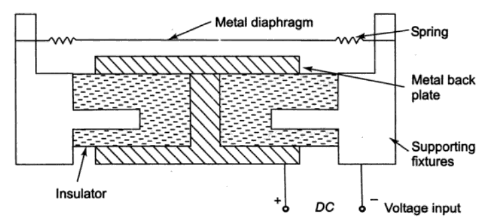
The metal diaphragm and the fixed metal are near each other and from a capacitance of few picofarads. A fixed DC voltage of about 50 to 100 volts is applied between the backplate and the movable diaphragm plate. The diaphragm is in stretched condition as it remains attached to the supporting fixtures with the help of spider springs. The two plates are insulated from each other. The capacitance of this microphone is about 30 pF.
Applications
- It is used as a standard microphone for calibrating other microphones.
- It is used in sound level meters.
- It is used in the professional high-fidelity recording.
ELECTRET MICROPHONES
External DC bias in a capacitor microphone makes it costly and unsuitable for filed work. In the electret microphone, the external DC bias is dispensed with.
The electret microphone is also a capacitor microphone, but it has a built-in charge. Insulating materials can trap a large quantity of fixed charge and can retain it indefinitely. The insulating material used is Teflon. The backplate of the microphone is coated with a thin layer of Teflon. The thin layer is charged negatively at the time of manufacturing. This negative charge remains trapped for a long period. The –ve charge induces +ve charge on the diaphragm. The positive charge on the diaphragm and negative change on the Teflon establish an electric field across the gap of the capacitor plates. The charge results in a terminal voltage. When the capacitance changes due to sound pressure, the charge tends to remain constant and hence the terminal voltage changes.
As the electret microphone is cheap, has good frequency response, is rugged, and does not need bias supply. It is also used small PA systems for clubs and small halls, to keep the low cost. It is very light, is also used as a tie-clip microphone for lectures and as radio microphones in sports meets.
CARBON MICROPHONES
When fine carbon granules enclosed in a case subjected to variations of pressure, the resistance of the granules changes. When such a device of carbon granules is connected in series with a load through a DC supply, the current through the load will vary in accordance with pressure variations on the carbon granules.
Construction
Fine carbon granules are enclosed between two metal plates. The upper plate called diaphragm is attached to a movable metal plate through a metal piston or plunger. The lower metal plate is fixed and is insulated from the diaphragm. A protective cover with holes is used to protect the unit.
A battery is connected between two metal plates. When the load is connected, current flows through the carbon granules and the load. Path of the current passes from the +ve battery terminal through the fixed plate, the resistance of carbon granules, movable metal plate, metal casing, and output transformer. The purpose of the output transformer is to eliminate the DC content of the microphone.
Applications
- Due to the limited frequency range, it is useful only in telephones.
- It is also sometimes used in portable radio communication sets.
TIE-CLIP MICROPHONES
It is an electret type tiny microphone that and be clipped on to a tie, lapel or any other convenient part of the clothing. An external amplifier made on a tiny chip of silicon is used inside the microphone. Even with a tiny amplifier and its cell, it is very light.
WIRELESS MICROPHONES
It uses a small frequency-modulated VHF transmitter of low power (a few milliwatts). Cable from the amplifier to a microphone is not needed. The signal is received by a VHF receiver placed at a suitable distance, then amplified and fed to the loudspeakers. It is useful in sports and many other functions.
